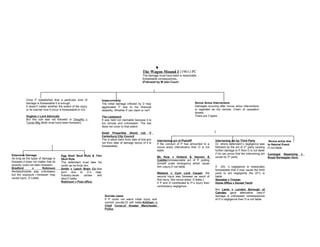Torts causation in_law
- 1. The Wagon Mound I (1961) PC The damage must have been a reasonable foreseeable consequences. (Followed by M`sian Court) Once P established that a particular kind of damage is foreseeable it is enough. It doesn’t matter whether the extent of the injury or its manner how it occur is foreseeable or not. Hughes v Lord Advocate But this rule was not followed in Doughty v Turner Mfg.(Both must have been foreseen) Estensive Damage As long as the tyype of damage is foreseen,it does not matter that its severity could not been foreseen. Bradford v Robinson Rentals(frosbite was unforeseen but the exposure r.foreseen may cause injury .D Liable. Egg Shell Skull Rule & Thin Skull Rule The defendant must take his victim as he finds him. Smith v Leech Brain Co.(lips burn due to D`s negl. Subseq.cause canser and died.D liable. Robinson v Post office. Impecuniosity The initial damage inflicted by D may aggravated P due to his financial disability. Whether P can claim or not? The Liesbosch It was held not claimable because it is too remote and unforeseen. The law does not cover to that extent. Dodd Properties (Kent) Ltd. V Canterbury City Council The ct allow claim from date of trial and not from date of damage becox of it is foreseeable) Novus Actus Interveniens Damages occuring after novus actus interveniens is regarded as too remote. Chain of causation breaks. There are 3 types. Intervening act of Plaintiff If the conduct of P has amounted to a novus actus interveniens then D is not liable. Mc Kew v Holland & Hannen & Cubitts(Unreasonable act of P putting himself under emergency which cause him unjury.D not liable. Wieland v Cyril Lord Carpet( the second injury was foreseen as result of first injury. Not novus actus. D liable.) If P and D contributed to P`s injury then contributory negligence Intervening act by Third Party Gr. where defendant`s negligence was followed by the act of 3rd party causing further damage to P then D is not liable if he can prove that the intervening act cause by 3rd party. If (Dl) `s negligence is reasonably foreseeable that it may cause the third party to act negligently the (D1) is liable. Stansbie v Troman Home Office v Dorset Yacht But Lamb v London Borough of Camden gave alternative view.If damage is unforeseen consequences of D`s negligence then D is not liable. Novus actus due to Natural Event D not liable. Carslogie Steamship v Royal Norwegian Govt. Suicide cases If P could not stand initial injury and commit suicide.Dl still liable.Kirkham v Chief Const.of Greater Manchester Police.
